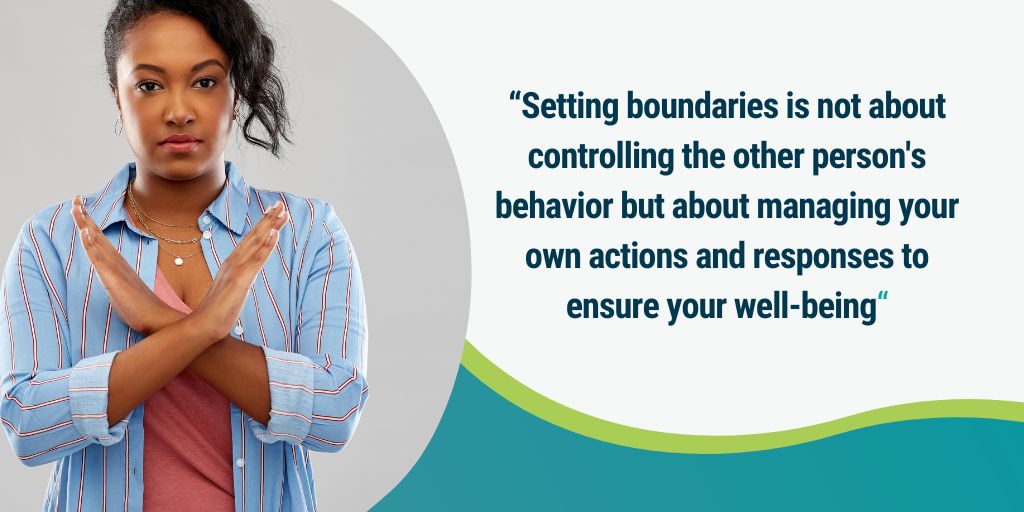
Navigating relationships with individuals diagnosed with Borderline Personality Disorder (BPD) can be challenging. The emotional volatility, fear of abandonment, and intense reactions that characterize BPD can make setting boundaries feel like walking a tightrope.
However, saying “no” is not only necessary for your own mental health but also beneficial for the person with BPD, as it provides structure and predictability.
This article aims to guide you on how to assertively communicate your needs and set healthy boundaries, all while maintaining empathy and understanding for the unique struggles faced by those with Borderline Personality Disorder.
Understanding Borderline Personality Disorder
Borderline Personality Disorder is a complex mental health disorder characterized by unstable emotions, self-image, and behavior. This instability often results in impulsive actions and tumultuous relationships.
People with BPD typically experience intense emotional swings and may display symptoms such as emotional instability, impulsive behavior, self-harm or suicidal tendencies, chronic feelings of emptiness, and intense but short-lived episodes of anxiety or depression.
A defining characteristic of BPD is a pattern of intense, unstable relationships. Individuals with BPD may idealize someone one moment and then suddenly believe the person doesn’t care enough or is cruel. This can result in a series of short-term relationships due to their fears of abandonment and rejection.
BPD can significantly impact a person’s ability to maintain stable interpersonal relationships. Their extreme emotional reactions can create a cycle of conflict, causing others to withdraw, which then reinforces their intense fear of abandonment. Understanding BPD and the different types of BPD is the first step towards managing these challenges and fostering healthier relationships.
Common Misconceptions about BPD
BPD is often misunderstood, leading to harmful stereotypes and stigmatization. Misunderstandings can create barriers to diagnosis and treatment, impede the individual’s recovery process, and cause unnecessary distress. Here are four common misconceptions about BPD:
- BPD is Untreatable: Contrary to this belief, BPD is treatable. Individuals can learn to manage their symptoms and lead fulfilling lives with therapy, such as Dialectical Behavior Therapy (DBT).
- People with BPD are Manipulative: This misconception arises from the impulsive behavior and emotional instability associated with BPD. However, these behaviors are symptoms of the disorder, not manipulative tactics.
- BPD Only Affects Women: While BPD is diagnosed more frequently in women, it affects both genders. Men may be underdiagnosed due to societal expectations and differing symptom presentations.
- People with BPD are Dangerous: While some individuals with BPD may exhibit self-harming behaviors or impulsivity, it doesn’t mean they’re inherently dangerous. Most people with BPD are more likely to harm themselves than others.
Understanding and challenging these misconceptions can promote empathy, improve care for those with BPD, and contribute to a more informed and supportive society.
Importance of Boundaries in Relationships with BPD Individuals
Setting boundaries in relationships with individuals diagnosed with Borderline Personality Disorder is crucial for maintaining a healthy relationship and self-care. Boundaries help create a sense of predictability and structure, which can mitigate the instability often associated with BPD.
However, setting and maintaining these boundaries can be challenging due to the fear of abandonment and volatile reactions that characterize BPD. For instance, saying no to someone with borderline personality disorder or setting a limit can trigger intense emotional responses, making it difficult to maintain the boundary without feeling guilty or fearful.
Nonetheless, establishing boundaries is essential. It can help reduce emotional chaos, prevent resentment, and promote respect in the relationship. It’s important to communicate these boundaries clearly, assertively, and consistently.
Remember, setting boundaries is not about controlling the other person’s behavior but about managing your own actions and responses to ensure your well-being. It’s also vital to seek professional help when needed, as therapists can provide valuable tools for managing the complexities of relationships with BPD individuals.

Strategies to Say No
Saying “no” to someone with Borderline Personality Disorder requires a careful and compassionate approach. This section will provide effective techniques and strategies to assertively communicate your boundaries without escalating conflict or causing harm. The goal is not just to say “no,” but to do so in a way that respects both your needs and the person’s feelings.
- Use Empathetic Assertion: Express your understanding of their situation or feelings before stating your boundary. This could look like: “I understand that you’re upset, but I need some time to myself right now.”
- Stay Calm and Consistent: Keeping your tone calm and your message consistent can help minimize volatility. Avoid matching their emotional intensity and reiterate your boundary if necessary.
- Avoid Justifying or Arguing: When setting a boundary, it’s important to avoid getting drawn into an argument or feeling the need to justify your decision excessively. Simply state your boundary clearly and assertively.
- Use ‘I’ Statements: Framing your boundary as a personal need can reduce defensiveness. For instance, instead of saying, “You’re too demanding,” you could say, “I need some time to relax after work.”
- Reinforce Positive Interactions: Reinforcing positive behavior can help build a healthier dynamic. If they respect a boundary, express your appreciation.
- Seek Professional Help: Therapists can provide strategies tailored to your situation and the person’s particular BPD symptoms. They can also offer support and coping mechanisms for you.
- Practice Self-Care: Setting boundaries can be emotionally draining. Taking care of your mental health and engaging in activities that help you relax and recharge is crucial.
Remember, setting boundaries is a process, and seeking help and taking time for yourself is okay. The aim is to foster healthier interactions and promote mutual respect in your relationship.
Get Professional Help Today
Dealing with BPD can be complex and challenging. A professional psychiatrist can provide essential support, tools, and strategies to navigate these challenges effectively. They can help you understand the disorder better, manage your reactions, and set healthy boundaries. Moreover, they can guide the person with BPD through proven therapies to manage their symptoms.
Don’t hesitate to seek help. My Psychiatrist is here for you. Please call us at (877) 548-8089. You can also use our Find a Provider page to locate a psychiatrist who best fits your needs. Remember, seeking help is not a sign of weakness but a step towards healthier relationships and improved wellbeing.

